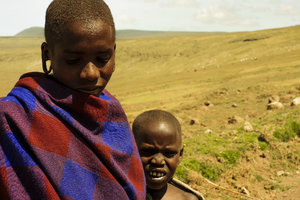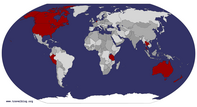Advertisement
Published: October 31st 2013

 Maasai Children
Maasai Children
We met many Maasai children along the wayFollowing our wonderful stay at St. Jude's we had a rigorous ten day adventure planned. Though we normally prefer to travel independently, the safari circuit in northern Tanzania is best booked through a tour operator. After much research we found we could hire a local driver/guide for not much more than the cost of a group tour. There were many companies to choose from, but in the end we found Duma Explorer - an operator who was based in Arusha (meaning our payment would go into the local economy rather than overseas), treated their employees well, gave back to the local communities, and offered good service and a good price. We were also able to customize our itinerary rather than having to choose from a pre-packaged tour so it was a great way to still travel somewhat independently while gaining all the benefits of booking through a tour operator. Our itinerary included four days trekking through a remote highland area and six days on a game driving safari.
After a quick breakfast at St. Jude's we went to the main gate and awaited the arrival of our Land Cruiser. Here we met our travel companions for the next ten days
- Tumain, a smiling man who would be our driver and guide; and Goodson, a quiet but friendly guy who would be the chef for our journey. Our first day was spent game driving in Lake Manyara National Park, but we'll save that for the next post. On the second day we began our trek! Most of our trek was within the boundaries of the Ngorongoro Conservation Area; another UNESCO World Heritage Site that is home to over 40,000 traditional Maasai people; a semi-nomadic tribe of traditional pastoralists, along with their herds of cattle and goats. The NCA is also home to a variety of wildlife and is a significant historical area often referred to as the "Cradle of Mankind" with archeological evidence of early human evolution. It is part of Africa's Great Rift Valley, which includes a few extinct volcanic calderas, as well as one active volcano. We started out early and had a couple hours drive to reach the ranger outpost in Nainokanoka. We stopped along the way to pick up our hiking guide from a small village. A young Maasai warrior, William would be our lifeline and source of information in the African wilderness. We also made
another stop enroute for William to pick up a spear from someone in another village. When we inquired later on about the spear he said to us, "I can use it to protect us from the cheetah or lion, like this..." as he throws the spear into the red earth, the end wobbling slightly back and forth with the spearhead firmly planted in the ground, "but mostly I am trained in the detection and avoidance of wildlife so we shouldn't have any problem."
We hope so, William! After a short drive from the ranger outpost down a dirt path which acts as the main road in the area, Tumain stopped to let us out. We were in a valley, surrounded by gentle ridges and small herds of zebra; and this was where we were to begin our trek. In the distance we could see a few Maasai people tending to their cattle; as well as the odd wildebeest, antelope, or ostrich. We had a quick bite to eat before the Land Cruiser left and then we began following the dirt path to the valley floor. After a short time William pointed to the high ridge in the distance and
told us that's where we were headed. We left the road and began the gentle climb through the pastureland. We encountered some Maasai children along the way - some shy, some excited to wave to us and sometimes run after us laughing and shouting in their native Maa language, with the odd "Hello!" or "Bye-bye!" in English. We asked William what they were saying, and he told us something along the lines of "Look at those strange white people! They are so strange they must be animals and not humans! Hahaha....." While we were not the first Caucasians these children had seen, tourists in this area aren't as common so I suppose we were still a novelty. William told us he had been the same way as a child. Most of the children we saw were looking after the herds of cattle and goats, sometimes on their own or sometimes with two or three other children.
We continued to hike, slowly but steadily gaining altitude. At times we were alone in the stunning African wilderness. We often passed small Maasai villages, complete with mud and stick huts and corrals for the livestock made of sharpened tree branches. William would

 Our Guide
Our Guide
"William"stop to chat with most everyone we passed. On occasion we would hear the name of the place we were heading to and then the men would point off into the distance. There are no marked trails in the region, and the Maasai do not use maps or a compass; but we were confident we would reach our destination eventually and no matter which way we went we would be "taking the scenic route" as the landscapes were beautiful. At a later time William told us that those discussions were primarily regarding the location of the buffalo herds. He said buffalo and elephants are the animals that are feared by the Maasai as they are large and can be rather ornery (particularly the buffalo) and because they travel in large herds they are not easy to fend off like a lion. While lions tend to be the first dangerous animals that comes to mind for most, they are not very feared by the Maasai. We arrived at our destination just before dusk. Though we were "wilderness camping" we were still expecting to have some kind of protection from the wildlife - perhaps similar to the livestock corrals we had encountered
en route. On the contrary, we were just camping in a small clearing beside the path and little-used road. Tumaini and Goodson had driven to the camping area ahead of time and had set up our camp which consisted of our two tents and a tarp set up to cover the dugout hole in the ground which would serve as our toilet facilities. We were camping in the clouds near the rim of Empakaai Crater; not another soul around for miles, the grunts and growls of the crater wildlife increasingly filling the cool and otherwise quiet night air. We were treated to a delicious three course dinner prepared over the fire by the wonderful Goodson before retiring early for the night. Physically we weren't too strained after the long trek, and though we weren't at excessive altitude we had climbed to over 3000 meters that day and with no acclimatization and heavy physical exertion I was feeling the affects of the altitude.
In the morning we descended into the crater. The caldera is lined with a dense jungle of lush cloud forest that steeply drops down to a large high-altitude soda lake. The lake is about five kilometers across,
encompassing the majority of the crater floor and has a crusty white border caused by the salt residue so common to this region. Flamingos frequent the lake and we were lucky enough to see some of them while we were down there. Our steps left footprints in the salt and we could see tracks of the animals we had fallen asleep listening to the previous night - leopard, hyenas, and buffalo to name a few. We spent about an hour exploring the area around the lake being careful not to stray too far from William's side - though we didn't see any wildlife we knew they were close by. We ascended the same steep switch-back pathway we had come down, listening for the buffalo as we climbed and stopping to appreciate the breathtaking vista looking back on the area we had just explored up close.
Our trek continued through the highlands of the Great Rift Valley. We were heading into the heart of the Maasailand and with no road networks we would be out of contact with our driver until the following afternoon. Another Maasai warrior joined Goodson with a couple of donkeys, acting as the porters for our
journey. Occasionally we would glimpse Ol Doinyo Lengai, the imposing volcano off in the distance that the Maasai literally refer to as the "Mountain of the Gods." As we got closer to this active volcano, we were amongst cooled lava pathways and volcanic rocks that had exploded from the volcano during major eruptions in 2007 and 2008. We camped the night at another "wilderness" campsite amongst the thorny yellow acacia trees. Every once in a while the donkeys would wander off a little too far and one of the Masaai men around the campsite would run off to bring them back to camp. We were treated to a stunning sunset, with a golden and green backdrop highlighting the beauty of the acacias.
Shortly after sunrise and a quick breakfast we headed out on a short hike through more volcanic influenced terrain. We walked through dried river basins carved out of the landscape by past lava flows as we descended from the highlands. As the terrain leveled off we saw Tumain in the distance, walking towards us to greet us after our trek and pick us up for the vehicle transfer to Lake Natron. Goodson and William joined us in
the Cruiser and the man with the donkeys turned around for a long walk back home. We had spent the last two and a half days trekking through the striking African wilderness. At times we were immersed in the true African culture, witnessing Maasai people going about their every day activities rather than putting on shows for tourists. Other times we were alone with our guide William, walking solo across a ridge as though we were the only people in Africa. We had hiked for about 45 kilometers and did not encounter another foreign traveler throughout our journey. It was spectacular!
Too see more of our photos, as well as some of our other photographic endeavours, please visit our website: www.doubleshotphotography.ca
Advertisement
Tot: 0.142s; Tpl: 0.014s; cc: 6; qc: 45; dbt: 0.0461s; 1; m:domysql w:travelblog (10.17.0.13); sld: 1;
; mem: 1.2mb

























